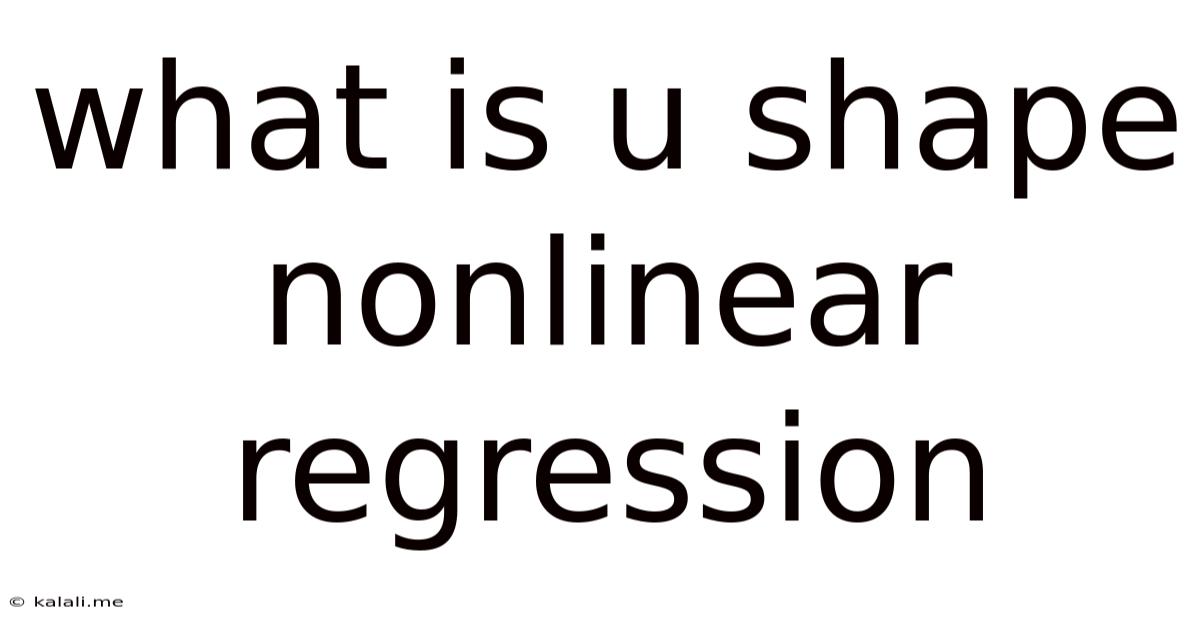What Is U Shape Nonlinear Regression
Kalali
May 23, 2025 · 3 min read

Table of Contents
What is U-Shaped Nonlinear Regression?
This article delves into the fascinating world of U-shaped nonlinear regression, explaining what it is, when to use it, and how it differs from other regression models. Understanding this type of regression is crucial for accurately modeling data exhibiting a particular curved relationship. We'll explore its applications and provide practical insights to help you determine if it's the right tool for your data analysis.
U-shaped nonlinear regression is a statistical method used to model relationships between a dependent variable and one or more independent variables where the relationship is characterized by a U-shaped curve. Unlike linear regression, which assumes a straight-line relationship, U-shaped regression acknowledges and accounts for the curvature, signifying an initial decrease followed by a subsequent increase in the dependent variable as the independent variable changes. This makes it invaluable in situations where a simple linear model would be insufficient and misleading.
Understanding the U-Shape
The defining characteristic of this type of regression is its U-shaped curve. This implies that the effect of the independent variable on the dependent variable is non-monotonic. Initially, as the independent variable increases, the dependent variable decreases. However, after reaching a minimum point, the dependent variable starts to increase again as the independent variable continues to rise.
This pattern often reflects complex relationships where an initial negative effect is eventually overcome by a positive effect. Several real-world scenarios exhibit this U-shaped relationship, including:
- The relationship between stress and performance: A small amount of stress can be beneficial, improving focus and performance, but excessive stress leads to decreased performance.
- The effect of fertilizer on crop yield: Too little fertilizer limits growth, while too much can damage the plants and reduce yield. An optimal amount exists somewhere in between.
- The relationship between advertising spending and sales: Initially, increased spending leads to increased sales, but after a saturation point, additional spending has diminishing returns or even negative effects.
How it Differs from Other Regression Models
Several other regression models exist to handle nonlinear relationships, each with unique characteristics:
- Linear Regression: This assumes a linear relationship; unsuitable for U-shaped data.
- Polynomial Regression: While capable of modeling curves, it doesn't inherently guarantee a U-shape. A quadratic polynomial (degree 2) can produce a U-shape, but higher-degree polynomials can create more complex curves.
- Exponential Regression: Models exponential growth or decay; unsuitable for U-shaped data.
- Logarithmic Regression: Models logarithmic relationships; also unsuitable for U-shaped data.
When to Use U-Shaped Nonlinear Regression
Employ U-shaped nonlinear regression when your data clearly suggests a U-shaped pattern. This involves visually inspecting scatter plots and considering the theoretical underpinnings of the relationship being modeled. Statistical tests can also help confirm the appropriateness of this model over other alternatives. Always remember to check the assumptions of the chosen regression model, such as the assumption of independence and homoscedasticity of residuals.
Choosing the Right Model and Performing the Regression
The specific mathematical form of the U-shaped regression model will depend on the data and context. Common choices include quadratic functions, but other functions might be more suitable depending on the specific characteristics of the relationship. Statistical software packages like R, Python (with libraries like scikit-learn and statsmodels), and SPSS offer tools to fit these models and assess their goodness of fit.
Conclusion
U-shaped nonlinear regression provides a powerful tool for analyzing data exhibiting a non-monotonic, U-shaped relationship. By understanding its characteristics and when it's appropriate to use it, researchers and analysts can gain valuable insights from their data that would be missed by simpler linear models. Remember to carefully examine your data and consider the theoretical background before selecting and interpreting the results of a U-shaped nonlinear regression. Proper diagnostics are crucial to ensure the validity of the results.
Latest Posts
Latest Posts
-
Freezing Point Of Water A C B F C K
May 23, 2025
-
How To Connect Two Lights On One Switch
May 23, 2025
-
Can You Use Plumbers Tape On Gas Lines
May 23, 2025
-
You Get More Bees With Honey Than Vinegar
May 23, 2025
-
Water Based Polyurethane Over Oil Stain
May 23, 2025
Related Post
Thank you for visiting our website which covers about What Is U Shape Nonlinear Regression . We hope the information provided has been useful to you. Feel free to contact us if you have any questions or need further assistance. See you next time and don't miss to bookmark.